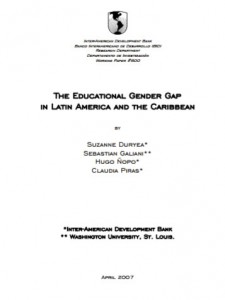The Educational Gender Gap in Latin America and the Caribbean
| Año | : | 2008 |
|---|---|---|
| Autor/es | : | Suzanne Duryea, , Hugo Ñopo, Claudia Piras |
| Área/s | : | Educación y aprendizajes, Etnicidad, género, ciudadanía y derechos |
Duryea, Suzanne; Sebastian Galiani; Hugo Ñopo y Claudia Piras( 2007). The Educational Gender Gap in Latin America and the Caribbean. Research Department Publications 4510, Inter-American Development Bank, Research Department.
The paper analyzes the evolution of gender differences in school attendance and attainment in Latin America and the Caribbean, for both adults who left the educational system and children in school. For individuals 21 years old and above the paper uses a cohort analysis of school attainment. The results indicate that the schooling gap has closed for the cohort born at the end of the 1960s. Since then, the gap has reversed such that within the cohort born in 1980, females have, on average, ¼ of a schooling year more than males. During the four decades of birth cohorts of our analysis (1940-1980) the gender gap in attainment has moved in favor of females at a pace of 0. 27 years of schooling per decade. A decomposition exercise suggests that the changes in the schooling gap are mainly explained by the educational attainment of females at the higher levels, rather than improvements in the early years of education. An analysis of attendance and attainment among girls and boys between 6 and 18, for Bolivia, Guatemala, Mexico and Peru (the countries that have not closed the gap in adult schooling attainment) reveals noticeable gender differences, favoring boys, only among older children of the lowest income quintiles and indigenous ethnicity.







